Allosteric coupling from G protein to the agonist-binding pocket in GPCRs
- PMID: 27362234
- PMCID: PMC5702553
- DOI: 10.1038/nature18324
Allosteric coupling from G protein to the agonist-binding pocket in GPCRs
Abstract
G-protein-coupled receptors (GPCRs) remain the primary conduit by which cells detect environmental stimuli and communicate with each other. Upon activation by extracellular agonists, these seven-transmembrane-domain-containing receptors interact with heterotrimeric G proteins to regulate downstream second messenger and/or protein kinase cascades. Crystallographic evidence from a prototypic GPCR, the β2-adrenergic receptor (β2AR), in complex with its cognate G protein, Gs, has provided a model for how agonist binding promotes conformational changes that propagate through the GPCR and into the nucleotide-binding pocket of the G protein α-subunit to catalyse GDP release, the key step required for GTP binding and activation of G proteins. The structure also offers hints about how G-protein binding may, in turn, allosterically influence ligand binding. Here we provide functional evidence that G-protein coupling to the β2AR stabilizes a ‘closed’ receptor conformation characterized by restricted access to and egress from the hormone-binding site. Surprisingly, the effects of G protein on the hormone-binding site can be observed in the absence of a bound agonist, where G-protein coupling driven by basal receptor activity impedes the association of agonists, partial agonists, antagonists and inverse agonists. The ability of bound ligands to dissociate from the receptor is also hindered, providing a structural explanation for the G-protein-mediated enhancement of agonist affinity, which has been observed for many GPCR–G-protein pairs. Our data also indicate that, in contrast to agonist binding alone, coupling of a G protein in the absence of an agonist stabilizes large structural changes in a GPCR. The effects of nucleotide-free G protein on ligand-binding kinetics are shared by other members of the superfamily of GPCRs, suggesting that a common mechanism may underlie G-protein-mediated enhancement of agonist affinity.
Figures


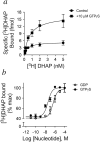

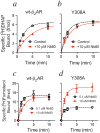




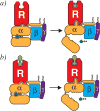
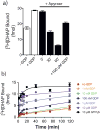


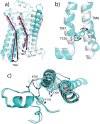

Similar articles
-
Allosteric nanobodies reveal the dynamic range and diverse mechanisms of G-protein-coupled receptor activation.Nature. 2016 Jul 21;535(7612):448-52. doi: 10.1038/nature18636. Epub 2016 Jul 13. Nature. 2016. PMID: 27409812 Free PMC article.
-
Single-molecule analysis of ligand efficacy in β2AR-G-protein activation.Nature. 2017 Jul 6;547(7661):68-73. doi: 10.1038/nature22354. Epub 2017 Jun 7. Nature. 2017. PMID: 28607487 Free PMC article.
-
Functional differences between full and partial agonists: evidence for ligand-specific receptor conformations.J Pharmacol Exp Ther. 2001 Jun;297(3):1218-26. J Pharmacol Exp Ther. 2001. PMID: 11356949
-
Structural features of β2 adrenergic receptor: crystal structures and beyond.Mol Cells. 2015;38(2):105-11. doi: 10.14348/molcells.2015.2301. Epub 2014 Dec 24. Mol Cells. 2015. PMID: 25537861 Free PMC article. Review.
-
Allosteric communication regulates ligand-specific GPCR activity.FEBS J. 2021 Apr;288(8):2502-2512. doi: 10.1111/febs.15826. Epub 2021 Apr 5. FEBS J. 2021. PMID: 33738925 Free PMC article. Review.
Cited by
-
Capturing Peptide-GPCR Interactions and Their Dynamics.Molecules. 2020 Oct 15;25(20):4724. doi: 10.3390/molecules25204724. Molecules. 2020. PMID: 33076289 Free PMC article. Review.
-
The Molecular Basis of G Protein-Coupled Receptor Activation.Annu Rev Biochem. 2018 Jun 20;87:897-919. doi: 10.1146/annurev-biochem-060614-033910. Annu Rev Biochem. 2018. PMID: 29925258 Free PMC article. Review.
-
Allosteric Effect of Nanobody Binding on Ligand-Specific Active States of the β2 Adrenergic Receptor.J Chem Inf Model. 2021 Dec 27;61(12):6024-6037. doi: 10.1021/acs.jcim.1c00826. Epub 2021 Nov 15. J Chem Inf Model. 2021. PMID: 34780174 Free PMC article.
-
Optogenetic approaches for dissecting neuromodulation and GPCR signaling in neural circuits.Curr Opin Pharmacol. 2017 Feb;32:56-70. doi: 10.1016/j.coph.2016.11.001. Epub 2016 Nov 19. Curr Opin Pharmacol. 2017. PMID: 27875804 Free PMC article. Review.
-
Charge Movements and Conformational Changes: Biophysical Properties and Physiology of Voltage-Dependent GPCRs.Biomolecules. 2024 Dec 23;14(12):1652. doi: 10.3390/biom14121652. Biomolecules. 2024. PMID: 39766359 Free PMC article. Review.
References
-
- Pierce KL, 1, Premont RT, Lefkowitz RJ. Seven-transmembrane receptors. Nat Rev Mol Cell Biol. 2002 Sep;3(9):639–50. - PubMed
-
- Venter JC, et al. The sequence of the human genome. Science. 2001;291:1304–51. - PubMed
-
- Sprang SR. G protein mechanisms: insights from structural analysis. Annu Rev Biochem. 1997;66:639–78. - PubMed
Publication types
MeSH terms
Substances
Grants and funding
- U19 GM106990/GM/NIGMS NIH HHS/United States
- P60DK-20572/DK/NIDDK NIH HHS/United States
- R01-GM083118/GM/NIGMS NIH HHS/United States
- R01-GM068603/GM/NIGMS NIH HHS/United States
- T32 GM007767/GM/NIGMS NIH HHS/United States
- T32GM007767/GM/NIGMS NIH HHS/United States
- R01 GM083118/GM/NIGMS NIH HHS/United States
- T32 GM008270/GM/NIGMS NIH HHS/United States
- P60 DK020572/DK/NIDDK NIH HHS/United States
- R01-NS28471/NS/NINDS NIH HHS/United States
- R01 NS028471/NS/NINDS NIH HHS/United States
- T32GM007315/GM/NIGMS NIH HHS/United States
- R01 GM068603/GM/NIGMS NIH HHS/United States
- R21 DA031418/DA/NIDA NIH HHS/United States
- T32GM008270/GM/NIGMS NIH HHS/United States
- U19-GM106990/GM/NIGMS NIH HHS/United States
- T32 GM007315/GM/NIGMS NIH HHS/United States
LinkOut - more resources
Full Text Sources
Other Literature Sources
Molecular Biology Databases

